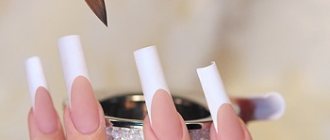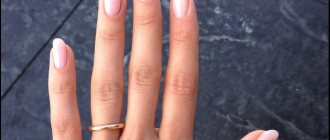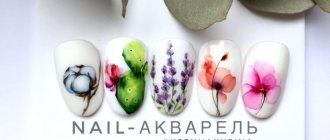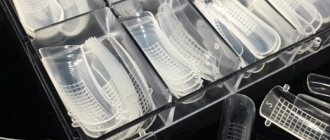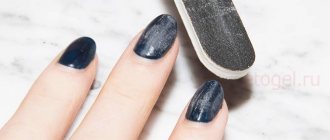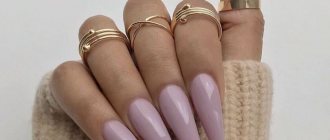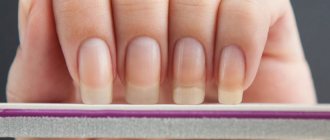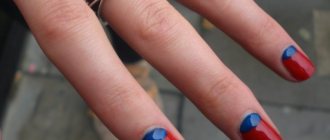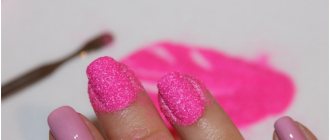Nail extension (modeling) - the formation of an artificial layer on top of the nail plate in order to strengthen and lengthen the nail, creating a decorative manicure. Today, artificial nails no longer surprise anyone: the simplicity and accessibility of the procedure have become an excellent solution for women who, due to weak nails or lack of time for constant nail care, cannot afford to grow natural nails.
Of course, the extension also needs care, but this falls entirely on the shoulders of your specialist. Depending on the growth rate of your nails, once every 2-4 weeks it is necessary to correct the extended nail, since the border between your own growing and extended nail is quite noticeable.
In no case should you engage in amateur activities, remove extended nails (especially with tips) at home, or try to do extensions at home without the proper experience and qualifications, as you can cause irreparable damage to your own nails.
There are various methods of nail extensions. The most common of them are acrylic and gel extensions, but it is worth mentioning such new products as shellac and silk extensions.
Judging by surveys, almost 80% of Russians like long nails on girls. Apparently, this is why extensions have become extremely popular in our country.
Acrylic
The acrylic nail extension scheme was the very first to be invented. Surprisingly, the author of the revolutionary invention is not a manicurist, but a dentist. Acrylic is widely used in dentistry because it is strong and durable, and also cures on its own, without the use of UV lamps. Using it, you can form any shape of the nail depending on the client’s wishes; a flexible and durable layer is formed that requires correction no more than once a month. The material itself may be odorless or have a rather strong odor.
There are 2 options for extension technology:
- in special flexible plate-forms;
- based on tips - artificial nail plates glued on top of the client’s own nail.
The first method is the most preferable, because the adhesion of acrylic to a natural nail is much stronger, and molding helps to significantly lengthen the nail even without using a tip, which is impossible with gel technology.
Stages of acrylic extension:
- filing and degreasing the nail plate;
- a special plate is determined and put on, which determines the shape of the future extended nail;
- a nail is formed from two-component acrylic;
- the finished hardened nail is filed and brought to its final shape;
- grinding, polishing, applying decorative varnish or nail art.
Advantages of acrylic extensions:
- Extreme flexibility and fracture toughness;
- Low cost;
- Correction is less frequent than with silk and gel extensions;
- Self-hardening of materials without the use of UV rays;
- There are practically no problems when wearing;
- The result will be good even if the work was done by a beginner;
- Acrylic nails are easy to remove;
- Acrylic nails do not deform natural nails and do not “pull” them;
- Acrylic nails are very thin and look natural;
- Acrylic coating protects the natural nail from negative environmental factors.
Disadvantages of acrylic extensions:
- Some ingredients have a very strong specific odor that can cause allergies;
- It is necessary to take breaks during which the nail requires an intensive course of recovery;
- Acrylic nails break along with your own nail, which is very unpleasant.
Types of nail extensions
Today, such a cosmetic procedure as nail extensions is quite common for the fair sex and almost every fifth girl turns to masters to make her nails beautiful and strong. There are several options for nail extensions, such as extensions using acrylic, gel, shellac, etc. The most common types are acrylic and gel.
One of the advantages of nail extensions is the fact that after the procedure you can forget about long-term home nail care. It is enough to use creams to care for the cuticle and hands in general. The varnish on an unnatural coating lasts longer than on your own nails, and this is undoubtedly a huge plus for women who have little free time.
One of the first types of such manicure is extension on forms. This is an easy, time-tested and quick method of extension. This type of manicure allows you to experiment with the shape, length and design of the nail. But more and more often, craftsmen refuse to apply acrylic to forms, since this material is toxic and emits a not very pleasant smell of chemicals.
The fragility of extended nails is a rather rare occurrence, unlike the fragility of natural ones. The acrylic coating is not applied in a thick layer, however, it is very durable. Nails can break only in cases where a woman is often in a hurry somewhere, is very worried, and also if the length of the nails is quite long.
Pregnant girls often have cases of nails peeling off; therefore, extensions can also break, but this is not always the case. The disadvantage of acrylic coating is that under the layer of extended nails, your nails become brittle, and in the future, after removing the acrylic, serious nail care is required to restore them. Based on this, it is recommended to take breaks in building up.
What are the advantages of acrylic nail extensions? And the fact is that such a coating looks natural, it can be worn even without applying varnish, and it is also possible to draw an arbitrary design. In addition, acrylic does not react to temperature changes, is easily removed, and even if damage occurs, quick correction of the nail is possible.
An alternative to acrylic extensions has become gel. Polymer gel is made already painted in various colors, which means that you don’t have to spend money on buying varnishes, but walk around with already colored nails. The gel also strengthens natural nails and has bactericidal properties.
Another advantage of such a coating is that the nails will be more flexible than with an acrylic coating, so cracks on the nails appear extremely rarely.
The disadvantage of gel nail coating is that the gel can quickly turn yellow. If a crack appears on the nail, repairing it will not be easy - you will have to completely remove the entire coating and re-build it. Removing gel nails is a rather intensive and time-consuming job; it is better not to do this on your own. The gel coating has to be completely cut off, which takes some time and is also not entirely pleasant for the owner of this manicure.
If a girl nevertheless makes a personal choice in favor of extended nails, then she deserves to take the choice of a specialist seriously. Firstly, in the office of a qualified specialist there must be certificates that indicate the completion of special courses. As a rule, the price for manicure services most often depends on the level of qualification of the master.
Secondly, an excellent salon should have at least three options for treating instruments - liquid and dry products, as well as ultraviolet lamps.
Thirdly, you should pay attention to the quality of gel and acrylic; you can even inquire about the availability of certificates for the quality of a particular material. And, of course, don’t be fooled by the low price tag and posters shouting that only in this salon you can get “super strong and never break” nails.
- Author: Author: Alena
Rate this article:
- 5
- 4
- 3
- 2
- 1
(2 votes, average: 3 out of 5)
Share with your friends!
Biogel
In essence, this technology is also gel, but with some differences.
Firstly, biogel is much healthier for nails than regular gel, because more than half of it consists of protein, which nourishes and strengthens nails; the technology has even been medically licensed.
The procedure itself is completely identical to standard gel extensions, the only difference is in removal: it does not have to be cut off, but can be removed using a bath of a special liquid.
Tips appeared in the 50s along with the fashion among Hollywood beauties for long nails. At first, natural nails were used as them, later they were cut out of film, plastic, tea bags... and only later did false nails appear in the form in which we know them now.
Fake nails.
The technique of nail extensions has been around for a long time. Until recently, women preferred false nails. They were glued with glue directly to the nail under the cuticle. This type of nail extension is still used today. Women resort to false nails only because they are cheap, the procedure itself does not take much time and you can do it yourself at home. However, such a procedure is harmful not only to your nail plate, but also to your health. Since the glue that is used there penetrates not only the nail, but the skin.
Silk
The newest method of extension is silk nail extension, which has a number of advantages over those described above. Modern materials - silk or fiberglass - are cut to the shape of the nail and glued onto a natural nail or tip (depending on the natural length of your nails).
Advantages of silk extensions:
- The plate is formed thin and very natural;
- The extended nail is resistant to breakage, as it is tightly compressed with the material;
- It allows air to pass through, therefore avoiding the greenhouse effect and the spread of bacteria;
- Allows you to correct your natural manicure by making “patches” from the material for cracks and tears in the nail plate.
Disadvantages of silk extensions:
- Nowadays, silk extensions are just beginning to gain popularity, so not every manicurist can successfully perform it.
Silk extension stages:
- trimming a natural nail;
- gluing tips;
- cutting out pieces of fiberglass or silk in the shape of nails;
- the patches are impregnated with an activator gel and glued to the nail;
- drying;
- gluing a new layer, etc. It is necessary that the nail is covered with several layers of material;
- polishing and applying decorative coating.
Silk nail extensions are an excellent solution for those who have contraindications for gel and acrylic extensions. It has no side effects: sweaty hands and injured nails are not a problem for him.
Extensions using acrylic.
In modern salons, acrylic, gel, and silk compositions are now used for nail extensions. Sometimes resin is added to the extension composition. Acrylic nail extensions are considered to be the most durable. This is due to the fact that the material has reliable and durable properties. But many masters do not undertake to work with acrylic. It is believed that it harms not only the nails, but also the body itself. However, to create decorative modeling you cannot do without acrylic. Modeling gives volume to extended nails, embodies any fantasy, and also decorates the manicure. Often modeling is used for wedding manicure.
Acrylic or gel? What is better / worse for nails? What is the difference?
